
Dexter Avenue Baptist Church is a Baptist church in Montgomery, Alabama, United States, affiliated with the Progressive National Baptist Convention. The church was designated as a National Historic Landmark in 1974 because of its importance in the civil rights movement and American history. In 1978 the official name was changed to the Dexter Avenue King Memorial Baptist Church, in memory of Dr. Martin Luther King Jr., who was pastor there and helped organize the Montgomery bus boycott in 1955 during the civil rights era. The church is located steps away from the Alabama State Capitol.

Massachusetts Avenue is a major diagonal transverse road in Washington, D.C., and the Massachusetts Avenue Historic District is a historic district that includes part of it.

Woodbridge is a historic neighborhood of primarily Victorian homes located in Detroit, Michigan. The district was listed on the National Register of Historic Places in 1980, with later boundary increases in 1997 and 2008. In addition to its historic value, Woodbridge is also notable for being an intact neighborhood of turn-of-the-century homes within walking or biking distance of Detroit's Downtown, Midtown, New Center, and Corktown neighborhoods.
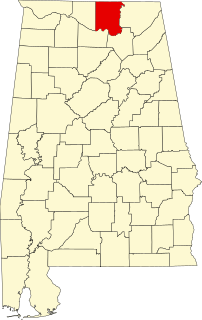
The following properties are listed on the National Register of Historic Places in Madison County, Alabama.

The Heaviest Corner on Earth is a promotional name given to the corner of 20th Street and 1st Avenue North in Birmingham, Alabama, United States, in the early 20th century. The name reflected the nearly simultaneous appearance of four of the tallest buildings in the South, the 10-story Woodward Building (1902), 16-story Brown Marx Building (1906), 16-story Empire Building (1909), and the 21-story American Trust and Savings Bank Building (1912).
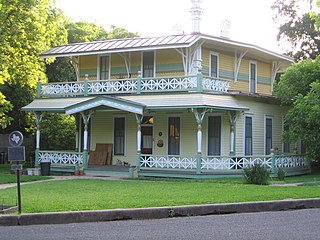
The Shadow Lawn Historic District is a historic district in central Austin, Texas that has a cohesive collection houses built in the southeast portion of Hyde Park during the late 1920s and 1930s.
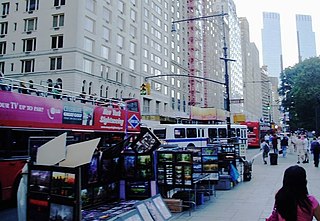
59th Street is a crosstown street in the New York City borough of Manhattan, running from York Avenue/Sutton Place on the East Side of Manhattan to the West Side Highway on the West Side. The three-block portion between Columbus Circle and Grand Army Plaza is known as Central Park South, since it forms the southern border of Central Park. The street is mostly continuous, except between Ninth Avenue/Columbus Avenue and Columbus Circle, where the Time Warner Center is located. While Central Park South is a bidirectional street, most of 59th Street carries one-way traffic.

The boundary markers of the original District of Columbia are the 40 milestones that marked the four lines forming the boundaries between the states of Maryland and Virginia and the square of 100 square miles (259 km2) of federal territory that became the District of Columbia in 1801. Working under the supervision of three commissioners that President George Washington had appointed in 1790 in accordance with the federal Residence Act, a surveying team that Major Andrew Ellicott led placed these markers in 1791 and 1792. Among Ellicott's assistants were his brothers Joseph and Benjamin Ellicott, Isaac Roberdeau, George Fenwick, Isaac Briggs and an African American astronomer, Benjamin Banneker.
The Bates–Hendricks neighborhood is situated just south and east of the downtown commercial district of Indianapolis, Indiana. The Fountain Square business district is just to the east.
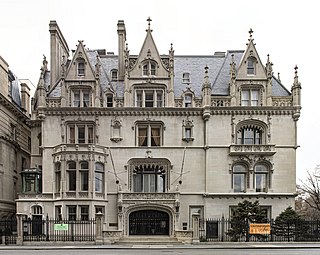
The Harry F. Sinclair House is a mansion at the southeast corner of East 79th Street and Fifth Avenue on the Upper East Side of Manhattan in New York City. The house was built from 1897 to 1899. Over the first half of the 20th century, the house was successively the residence of businessmen Isaac D. Fletcher and Harry F. Sinclair, and then the descendants of Peter Stuyvesant, the last Director of New Netherland. The Ukrainian Institute of America acquired the home in 1955. After the house gradually fell into disrepair, the institute renovated the building in the 1990s. The house was added to the National Register of Historic Places and was named a National Historic Landmark in 1978.
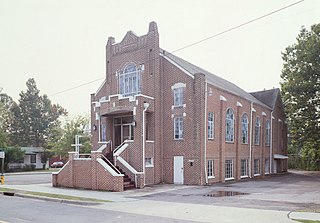
Bethel Baptist Church is a Baptist church in the Collegeville neighborhood of Birmingham, Alabama. The church served as headquarters from 1956 to 1961 for the Alabama Christian Movement for Human Rights (ACMHR), which was led by Fred Shuttlesworth and active in the Birmingham during the Civil Rights Movement. The ACMHR focused on legal and nonviolent direct action against segregated accommodations, transportation, schools and employment discrimination. It played a crucial role in the 1961 Freedom Ride that resulted in federal enforcement of U.S. Supreme Court and Interstate Commerce Commission rulings to desegregate public transportation.

The Midtown Historic District is a historic district in the city of Mobile, Alabama, United States. It was placed on the National Register of Historic Places on November 29, 2001, with a small boundary increase on November 18, 2020 It is roughly bounded by Taylor Avenue, Government Street, Houston Street, Kenneth Street, Springhill Avenue, and Florida Street. The district covers 467 acres (1.89 km2) and contains 1,270 contributing buildings. The majority of the contributing buildings range in age from the 1880s to the 1950s and cover a wide variety of architectural styles. The district was significantly affected by a tornado on December 25, 2012.
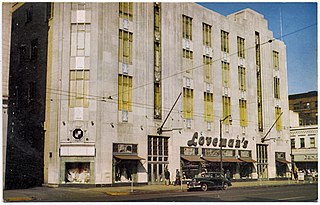
Loveman's of Alabama was a Birmingham, Alabama-based chain of department stores with locations across Alabama. It adopted this name to distinguish it from Loveman's department stores operating in Chattanooga, Tennessee, and in Nashville, Tennessee.

George Bigelow Rogers (1870–1945) was an American architect, best known for the wide variety of buildings that he designed in Mobile, Alabama, including mansions in historic European styles and other private residences, churches and public buildings, and the first 11-story skyscraper in Mobile and the Southeast United States. Many of his structures have been listed on the National Register of Historic Places.

Atkins Park is an intown neighborhood of Atlanta, Georgia, nestled against the southeast corner of the neighborhood of Virginia-Highland, west of Briarcliff Avenue and north of Ponce de Leon Avenue ("Ponce"). It consists of just three streets - St. Louis Place, St. Charles Place, and St. Augustine Place - as well as an internal sidewalk known as Malcolm's Way that bisects them from St. Charles to St. Louis. It was originally designed to give quicker access to the streetcar stop at Ponce.

The W. S. Salmon House in southeast Portland in the U.S. state of Oregon, is a 2.5-story apartment house listed on the National Register of Historic Places. Built in the Queen Anne style in 1890, it was added to the register in 1994.

The Awbury Historic District is a historic area in the East Germantown neighborhood of Philadelphia, Pennsylvania. It encompasses the former summer homes and farms of the extended Cope family, who moved to the area starting in 1849 and the entire Awbury Arboretum, which occupies most of the district's area, as well as adjacent properties developed and occupied by Henry Cope (1793-1865), son and successor to prominent Philadelphia Orthodox Quaker merchant Thomas Pym Cope (1768-1854), his close relatives, and his descendants. The district, which has been described by Philadelphia area historians as "visually distinct from the densely-built urban blocks that surround it on three sides, and from the level, open landscape of the city park to the northwest," features buildings which were designed in the Gothic Revival, Italian Villa, Queen Anne, Tudor Revival, Shingle, and Colonial Revival styles of architecture between 1849 and 1922.

The George P. Lent Investment Properties, also known as Firehouse Row, in southeast Portland in the U.S. state of Oregon, consists of a group of five similar 1.5-story, single-family houses listed on the National Register of Historic Places. Built in 1893, the group was added to the register in 1989. The Queen Anne style houses are next to one another at the corner of Southeast 7th Avenue and Southeast Harrison Streets. They are commonly referred to as Firehouse Row because firemen from the adjacent Portland Fire Station No. 23 sometimes lived in them.
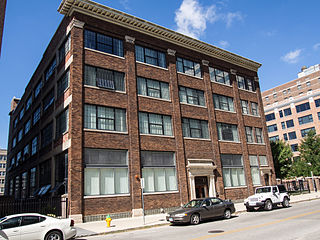
The Standard Glass and Paint Company Building, also known as 10th Street Lofts, is an historic building located in downtown Des Moines, Iowa, United States. Ashton and Ross Clemens, who were brothers, had the building built in 1913 to house their company, which was said to be the largest glass and paint business west of Chicago. Local contractor J.E. Lovejoy was responsible for its construction. It was one of several warehouse buildings on the southwest corner of the downtown area. Established by the Clemens brothers, Standard Glass and Paint Company was in existence from 1903 to 1979. It was Des Moines' leading wholesale and retail supplier of a variety of building and remodeling supplies. The company remained in this building until the mid-1920s when they moved to the Clemens Automobile Company Building, which was owned by the same family. After it sat empty until 1931 various wholesale companies occupied this building over the succeeding years. Along with the neighboring Herring Motor Car Company Building it has been converted into loft apartments. It was listed on the National Register of Historic Places in 2004.

Ponce de Leon Apartments is a historic apartment building in Atlanta, Georgia, United States. A part of the Fox Theatre Historic District, the building is located at the intersection of Peachtree Street and Ponce de Leon Avenue in midtown Atlanta. It was built by the George A. Fuller Company in 1913, with William Lee Stoddart as the building's architect. The building was designated a Landmark Building by the government of Atlanta in 1993.






















